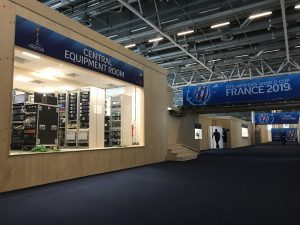FIFA TV Production of Women’s World Cup Rises to New Level To Meet Growing Fan Demand
The goal is not just higher quality but greater quantity of content as well
Story Highlights
The FIFA Women’s World Cup 2019 is set to begin today (June 7) in Paris with France taking on South Korea, and FIFA TV’s efforts around the event continue to expand to meet the growing demands of rightsholders and an expanding global audience. Not only will the live match coverage take a step up in quality, but the total amount of produced content available to rightsholders will almost double that of the 2015 edition.
“We are hoping to reach 1 billion unique viewers for this Women’s World Cup,” says Florin Mitu, head of host broadcast production, FIFA. “The trend has been going in this direction ever since Germany 2011.”
He adds that the fact that there are 62 rights licensees shows that the competition is enjoying healthy organic growth.
“And, more than just the number of broadcasters,” he adds, “the profile of the broadcasters themselves is growing, meaning that the FIFA Women’s World Cup can reach wider and more diverse audiences.”
As with any FIFA TV production, there are two key components: the operations at the venue and the operations at the International Broadcast Center (IBC).
Given the nature of the event — 52 matches at nine stadiums across the country and a schedule that allows production teams and assets to be used at more than one stadium — six host production crews will help ensure that matches are produced to the highest quality. Each match will be produced using a mix of 1080p and UHD cameras and resources, with 24 cameras at the core for all the matches.
The opening match today, the semifinals, and the final (to be played in Lyon on July 7) will have five additional cameras: a cable camera, two additional super-slo-mo cameras, and two ultra-motion Polecams. In addition, all matches will have three handheld cameras that will capture pre/post-match excitement.
“The evolution of the HD era from Germany to France has seen us go from 1080i and 4:3 to being fully 16:9 this year and with UHD SDR and then 1080p as a second output and with the world feed being 1080i,” says Mitu. “Audio-wise, we will stay with Dolby 5.1.”
One major difference in production philosophy vs. the FIFA World Cup is that FIFA TV and its experienced appointed host broadcaster HBS will operate out of regular remote-production vehicles rather than the two-story cabins that have become familiar at the venues of the men’s event. But the goal, more than ever, is to make sure that the end product delivered to viewers meets growing interest and demand for quality coverage.
“What our coverage will show over the next month is that the FIFA Women’s World Cup is now very much a premium competition and all 52 matches are produced accordingly,” adds Mitu. “Fans everywhere have come to expect a certain production standard of major FIFA competitions, and we want to meet their expectations with a state-of-the-art UHD offering. Furthermore, we are proposing rights licensees tailored social-media content, including 360° videos, stills, infographics, and near-live videos, via a dedicated web-based interface.”
At the IBC
The hub of activity will be the IBC, which will take up more than 5,000 sq. meters of the Paris Expo Porte de Versailles in the southwest of Paris. Seven rightsholders will join FIFA TV’s production staff of 230 this year at the IBC: TF1, Canal+, ARD/ZDF, BBC, CCTV, Fox Sports U.S., and Telemundo. In 2015, there were only five.
One of the key service offerings for the rightsholders both at the IBC and beyond is the FIFA Media Asset Exchange (FIFA MAX) server. The server will offer not only a wealth of content around the matches but also preproduced content, such as host-city profiles, promotional trailers, and preview films.
It all adds up to around 1,700 hours of non-live content, and, each day during competition, rightsholders will have upwards of eight hours of fresh content, including match previews, highlights, and interviews. And from 2½ hours before kickoff to an hour after the match, footage of arrivals, post-match press conferences, highlight clips, and more will be available.
One advance from 2015 is that those who are not onsite will be able to access the server.
“This was one of the key messages we kept hearing following the FIFA World Cup in Russia,” says Mitu. “Broadcasters would like to be more independent and be able to receive the footage at their headquarters back home, as if they were in the IBC. So we took that on and are launching it.”
One major expansion this year is the number of TV crews that will follow the teams. In 2015, there were only six crews, with one deployed to each host city. This year, a crew will be dedicated to each of the 24 teams, covering training sessions, post-match press conferences, and in-depth interviews.
“They will actually stay with the teams, travel with them, eat with them,” says Mitu. “There will be hardly any moment of the experience missed.”
The team at the IBC will also create eight feeds for rightsholders around each match: basic international feed, UHD SDR basic international feed, clean international feed, additional content channel, beauty/MCP tactical channel, aerial/GHIR tactical, unilateral/camera iso 1, and an iso-feed channel with five camera feeds.
Also onsite at the IBC will be the video assistant referee, or VAR operations. The VAR team will operate remotely at the IBC. Similar to last year in Russia, it will follow the match from the Video Operation Room and will be in direct contact with the referee officiating in the stadium via a sophisticated fiber-linked system.
“With the content we are providing this year, we are going for quality as much as quantity,” adds Mitu. “We know that broadcasters are keen to receive ready-to-air items that will keep the viewers glued to their screens.”
The FIFA Women’s World Cup 2019 takes place in France between June 7 and July 7.


